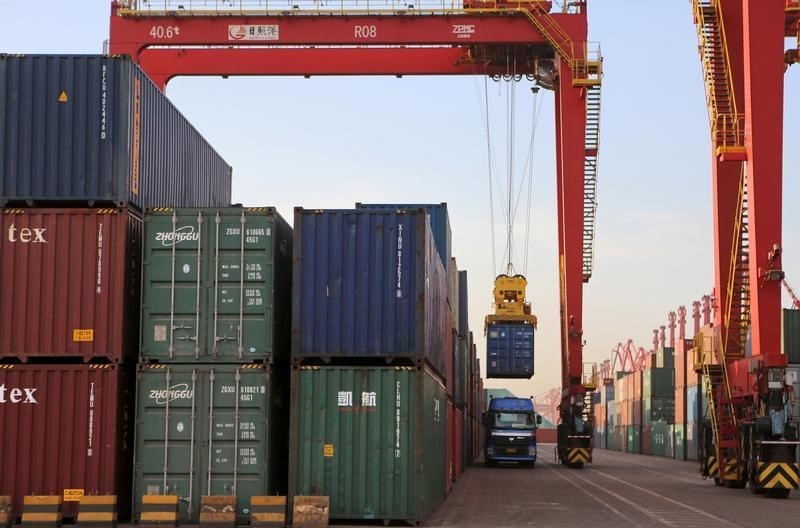By Xiaoyi Shao and Pete Sweeney
BEIJING/SHANGHAI (Reuters) - China's exports fell less than expected in September, with monthly figures showing recovery, but a sharper fall in imports left economists divided over whether the country's ailing trade sector is showing signs of turning around.
On the surface, the trade data on Tuesday reinforced views that the world's second-largest economy is still slowly losing momentum, putting more pressure on Beijing to roll out further stimulus measures and keeping global markets on edge.
But the numbers did not suggest a greater risk of a hard landing, either, as some investors have feared.
Exports fell 3.7 percent from the same period last year, less than a 6.3 percent drop forecast by economists in a Reuters poll and moderating from a 5.5 percent decline in August.
However, imports by value tumbled for the 11th straight month, losing over 20 percent year-on-year in September due to weak commodity prices and soft domestic demand, which will continue to complicate Beijing's efforts to stave off deflation.
Economists had expected a 15.0 percent drop, after a 13.8 percent decline in the previous month.
Highlighting persistent weakness in demand at home and abroad, China's combined exports and imports fell 8.1 percent in the first nine months of the year from the same period in 2014, well below the full-year official target of 6 percent growth.
That will likely reinforce expectations that Beijing will cut interest rates again in coming months and announce other measures to avert a sharper economic slowdown.
"In general, there are no green shoots in this set of data," said Zhou Hao, senior economist at Commerzbank (DE:CBKG) in Singapore.
"The growth of port throughput volume still remains low."
However, monthly figures were more rosy.
China's exports to every major market except Taiwan rose from August, as did imports, and some economists were inclined to give that more weight than year-on-year changes. For a table on trade with major markets, see.
Julian Evans-Pritchard of Capital Economics warned that annual export readings may be distorted downward by comparisons with strong export performance at the end of 2014, which many suspected was inflated by yuan speculation disguised as trade.
He suggested paying closer attention to monthly trends, which show a steady rise to most major export markets in the U.S. and Europe over the summer.
"Basically, exports have been doing better since the second quarter, but that recovery trend has been masked on a year-on-year basis because the second half of 2014 was so strong."
Evans-Pritchard also said that import data had become unreliable given massive swings in prices due to the commodity downturn and a divergence between prices and trading volumes.
"For the major commodities like oil, copper, etc. we're actually seeing a pretty healthy trend in import volumes."
Indeed, China's imports of copper, iron ore, crude oil and coal all rose in September from August, data from the General Administration of Customs showed on Tuesday.
Still, import volumes are a leading indicator for exports in China, given a large share of materials and parts are re-exported as finished goods, keeping the outlook cloudy.
"September's import figure does not bode well for industrial production and fixed asset investment," ANZ economists wrote in a research note.
"Overall growth momentum last month remained weak and third-quarter GDP growth to be released next Monday (Oct. 19) will likely have edged down to 6.4 percent in the third quarter, compared with 7 percent in the first half."
Growth below 7 percent would be the weakest since the global financial crisis.
China posted a trade surplus of $60.34 billion for September, the General Administration of Customs said on Tuesday, higher than forecasts for $46.8 billion and up slightly from $60.24 billion in August.
While the surplus is largely due to weak imports, it does help ease pressure on the country's money supply from capital outflows, ANZ argued.
SLOWDOWN FEARS
China is widely expected to post its slowest economic growth in a quarter of a century this year amid weak demand, factory overcapacity, high debt levels and cooling investment, but there are doubts over whether Beijing can do much about it.
Repeated monetary easing and fiscal stimulus over the past year have yet to revive growth as debt-laden companies are in no mood to expand as the economy cools. Beijing is also reluctant to prop up exporters at the low end of the value chain.
"I really don't think there's much the government can do policy-wise to boost exports in the short run – it primarily reflects external weakness," said Paul Tang, chief economist at the Bank of East Asia in Hong Kong. "They can do things to help boost competitiveness, but everything there is long term."
In fact, developed economies are to blame for the global economic malaise because their slow recoveries were not creating enough demand, China's Finance Minister Lou Jiwei was quoted as saying over the weekend.
IMF Managing Director Christine Lagarde said last week that the world could get stuck in a muddle of mediocre growth unless policymakers take economic reforms more seriously.
"The latest snapshot of the global economy looks uneasily familiar: a brittle, uneven recovery, with slower-than-expected growth and increasing downside risks," Lagarde said.
China's leaders will signal later this month that growth is their priority over reforms by setting a growth target of around 7 percent in their next long-term plan even as the economy loses momentum, policy insiders told Reuters.
